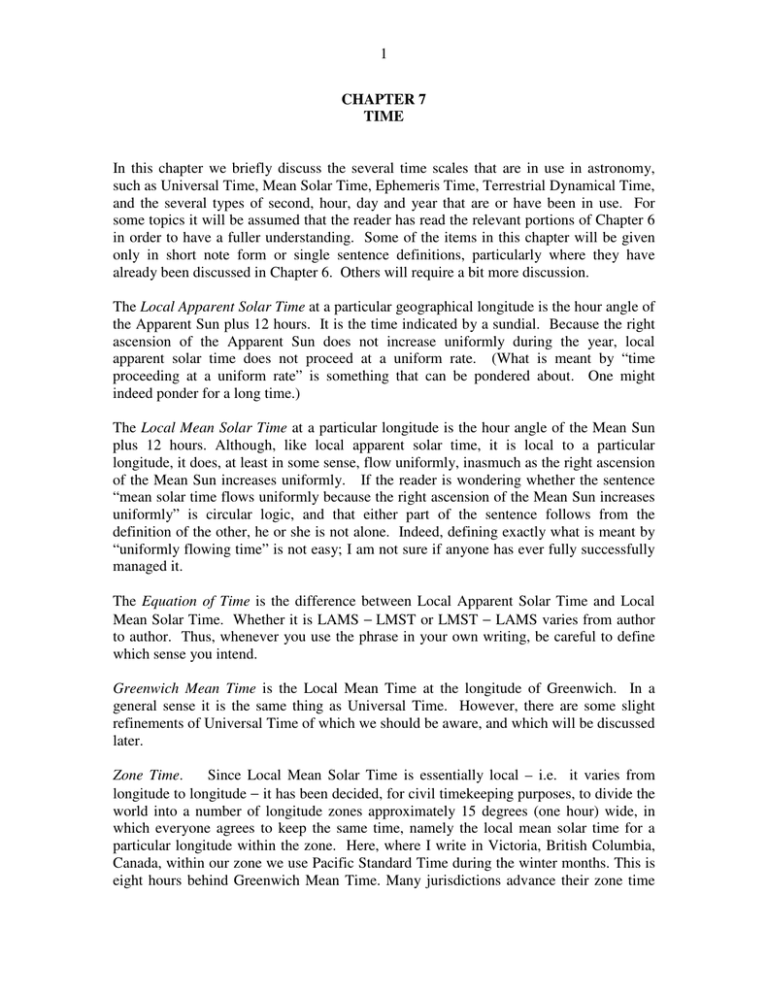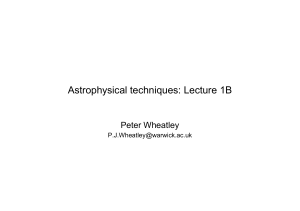1 CHAPTER 7 TIME In this chapter we briefly discuss the several
advertisement

1 CHAPTER 7 TIME In this chapter we briefly discuss the several time scales that are in use in astronomy, such as Universal Time, Mean Solar Time, Ephemeris Time, Terrestrial Dynamical Time, and the several types of second, hour, day and year that are or have been in use. For some topics it will be assumed that the reader has read the relevant portions of Chapter 6 in order to have a fuller understanding. Some of the items in this chapter will be given only in short note form or single sentence definitions, particularly where they have already been discussed in Chapter 6. Others will require a bit more discussion. The Local Apparent Solar Time at a particular geographical longitude is the hour angle of the Apparent Sun plus 12 hours. It is the time indicated by a sundial. Because the right ascension of the Apparent Sun does not increase uniformly during the year, local apparent solar time does not proceed at a uniform rate. (What is meant by “time proceeding at a uniform rate” is something that can be pondered about. One might indeed ponder for a long time.) The Local Mean Solar Time at a particular longitude is the hour angle of the Mean Sun plus 12 hours. Although, like local apparent solar time, it is local to a particular longitude, it does, at least in some sense, flow uniformly, inasmuch as the right ascension of the Mean Sun increases uniformly. If the reader is wondering whether the sentence “mean solar time flows uniformly because the right ascension of the Mean Sun increases uniformly” is circular logic, and that either part of the sentence follows from the definition of the other, he or she is not alone. Indeed, defining exactly what is meant by “uniformly flowing time” is not easy; I am not sure if anyone has ever fully successfully managed it. The Equation of Time is the difference between Local Apparent Solar Time and Local Mean Solar Time. Whether it is LAMS − LMST or LMST − LAMS varies from author to author. Thus, whenever you use the phrase in your own writing, be careful to define which sense you intend. Greenwich Mean Time is the Local Mean Time at the longitude of Greenwich. In a general sense it is the same thing as Universal Time. However, there are some slight refinements of Universal Time of which we should be aware, and which will be discussed later. Zone Time. Since Local Mean Solar Time is essentially local – i.e. it varies from longitude to longitude − it has been decided, for civil timekeeping purposes, to divide the world into a number of longitude zones approximately 15 degrees (one hour) wide, in which everyone agrees to keep the same time, namely the local mean solar time for a particular longitude within the zone. Here, where I write in Victoria, British Columbia, Canada, within our zone we use Pacific Standard Time during the winter months. This is eight hours behind Greenwich Mean Time. Many jurisdictions advance their zone time 2 by one hour during the summer months; thus in the summer here in Victoria, we use Pacific Daylight-saving Time, which is just seven hours behind Greenwich Mean Time. It needs to be remembered that, to change from the Standard time for a given zone to Daylight-saving time, clocks are advanced by one hour in spring, and that “spring” occurs six months apart in the northern and southern hemispheres! The standard zone time for Sydney, Australia, is 18 hours ahead of the standard time for Victoria, Canada. But in December, it is summer in Australia and winter in Victoria; Sydney is then on Daylight-saving Time while Victoria is on Pacific Standard Time – a difference of 19 hours. In June, Victoria is on Daylight-saving Time while Australia is on Standard Time, a difference of 17 hours. These complications have to be understood by those who are planning international telephone calls! Local Sidereal Time is the hour angle of the First Point of Aries, and is equal to the hour angle plus right ascension of any star. A Mean Solar Day is the interval between two consecutive upper meridian transits of the Mean Sun. A Mean Sidereal Day is the interval between two consecutive upper meridian transits of the mean equinox. It is equal to 23h 56m 04s.091 of mean solar time. The rotation period of Earth relative to the fixed stars is 23h 56m 04s.099 of mean solar time. Transits of are slightly closer together because of the westward precessional motion of along the ecliptic. A Sidereal Year is the period of revolution of Earth around the Sun relative to the fixed stars, and it 365d.25636, where “d” denotes “mean solar days”. A Mean Tropical Year is the mean time required for the Apparent Sun to increase its ecliptic longitude by 360o. It is the interval that determines the seasons and is equal to 365d.24219. It is less that a sidereal year because of the westward motion of along the ecliptic. An Anomalistic Year is the interval between two consecutive passages of Earth through perihelion. It is equal to 365d.25964. It is longer that the sidereal year because of the forward motion of perihelion. In days gone by, when life was simpler, a second was merely the fraction 1/86400 of a mean solar day. As time-keeping became more and more precise, it became evident not only that time could be measured more precisely in the laboratory with atomic clocks than the rotation of Earth could be measured, but that Earth itself was not a perfect timekeeper, because it does not rotate uniformly when measured with an atomic clock. This is presumably because of unpredictable changes within the body of Earth which change its rotational inertia. This again raises the question of what is meant by “uniformly flowing time”. Whatever is meant by it, atomic time is presumed to be a better representation of it than an irregularly rotating Earth. 3 At present, the SI (Système International) definition of the second is the interval of 9192 631 770 periods of the radiation corresponding to the transition between the hyperfine levels F = 0 and F = 1 of the ground level 2S1/2 of the caesium isotope 137Cs. While it can easily be argued that this definition of the second is superior in numerous respects to the definition based on the rotation of Earth, it must be noticed that this definition is useful (albeit very useful) only for determining intervals of time – i.e. how many seconds have elapsed between event A and event B. By itself, the definition does nothing to determine the instant of time of a single event. It tells us nothing about how far Earth has rotated on its axis (time of day) or how far it has moved in its orbit around the Sun (time of year). There is still a need for a time scale for determining the instant of time of astronomical events and to use as a “uniformly-flowing” time as argument in celestial mechanical calculations and the provision of ephemerides. International Atomic Time (TAI – from the initial letters of the French name, Temps Atomique International) does enable us to define an instant of the time of occurrence of an event, since it is defined by the “ticking” of a caesium atomic clock beating out SI seconds of atomic time, which started at the beginning of the day 1958 January 01. That is, it has a unit of time and a starting point. Many seconds have elapsed since that epoch, however, so you can compare it with the “time of day” or with Greenwich Mean Time, by subtracting 86400 seconds whenever the number of seconds exceeds this number. That is, TAI is the number of seconds that have elapsed since the initial epoch, “modulo 86400”. This will not agree exactly with Greenwich Mean Time (i.e. the hour angle of the Mean Sun at Greenwich plus 12 hours) unless Earth rotates uniformly when compared with an atomic clock. It does not, quite, so one may ask which clock is “at fault”, or which clock is “running uniformly”. Most of us will probably agree that it is the atomic clock that is running uniformly and that the difference between TAI and GMT is caused by irregularities in the rate of rotation of Earth relative to TAI. Thus we may be tempted, for many purposes, to prefer to measure time interval with an atomic clock than to use the rotation of Earth as our time keeper. This is valid indeed, if all we want to do is to measure the interval of time between two events – but it still does not tell us where the Sun (whether Mean or Apparent) is in the sky, and we still need a time scale, whether it is uniform or not, that tells us the hour angle of the Sun. The required time scale is Universal Time, which is the hour angle of the Mean Sun at Greenwich plus 12 hours, and is, for most purposes, the same as Greenwich Mean Time. However, for very precise work, there are several subtly-different varieties of Universal Time. In principle, we could determine UT by measuring the hour angle of the Mean Sun – if only we could see the Mean Sun and record exactly when it crosses the meridian. In practice, UT is determined by recording the transit times of stars, and calculating the Universal Time from the observed Local Sidereal Time. If you do this, you get what is known as UT0. However, small corrections are necessary to account for variation of latitude(see section 6.7) and polar motion (slippage of Earth’s crust with respect to the body of the planet), and when these corrections are made, we arrive at UT1. These corrections are not sufficient, however, to keep Universal Time always in exact agreement with TAI, and whenever UT1 differs from TAI by as much as 0.9 seconds, a 4 leap second is added to (or in principle, if not in practice, subtracted from) UT1 to arrive at Coordinated Universal Time UTC, which thus never differs from TAI by as much as a second. Leap seconds are typically added at the end of a year, or sometimes in mid-year. The time signals broadcast by radio and over the Internet are UTC, and announcements are made whenever a leap second is inserted. Whenever a leap second is inserted, the minute during which it is inserted has 61 seconds, and an announcement is made. Normally the instant of time at which astronomical events are observed (such as lunar occultations) should be recorded and reported in UTC. Of course, if the observation is not made with a precision of better than a second (e.g. the commencement of a lunar eclipse), one should not pretend that one can distinguish between the various versions of UT, and the time recorded should be “UT”. To say “UTC” under such circumstances is to pretend to a greater precision than was actually achieved – rather like quoting a measurement to too many significant figures. While Universal Time tells us the “time of day” – i.e. how far Earth has rotated on its axis – it is not the argument of time needed in the theoretical calculation of orbital ephemerides. For much of the twentieth century, the time scale used for theoretical ephemeris calculations was Ephemeris Time, ET. ( I believe a movie was made about Ephemeris Time. At least the title of the movie was ET, so I presume that’s what it was about, though I haven’t actually seen it.) Ephemeris time was based not on the (irregularly rotating) Earth, but in principle on the motion of Earth in its orbit around the Sun, which was presumed to be “uniform”. (In practice, ET was calculated from observations of occultations of stars by the Moon, the motion of the Moon in its orbit being supposed to be calculated using a uniformly-flowing Ephemeris Time.) Just as TAI has a unit of time (the SI second) and an initial epoch (1958 January 01), so ET had a unit of time (the mean tropical year) and an initial epoch (1900 January 0d 12h ET). While ET was much more satisfactory as the “uniformly-flowing” argument of time necessary for ephemeris or other celestial mechanical calculations, it eventually had to be admitted that intervals of atomic time could be determined much more precisely than on any other time scale, and consequently ephemeris time (ET) was replaced in 1984 by Terrestrial Dynamical Time (TDT) as the independent argument of supposedly uniformly-flowing time for ephemeris calculations. Unlike ET, the unit of time is not the mean tropical year but it is the SI second of time based on the hyperfine transition of caesium as defined earlier in the chapter. And the starting point for TDT is defined such that at the instant 1977 January 01d 00h 00m 00s TAI was the same instant as 1977 January 01d.0003725. Since 0d.0003725 is 32s.184, TDT is equal to TAI plus 32s.184. This was re-named simply Terrestrial Time (TT) in 1991. Like TDT, TT was ahead of TAI by 0d.003725 at 1997 January 01d.0 TAI, the difference being that the unit of time interval in TT was defined in 1991 as the SI second at mean sea level. (At mean sea level? What has that got to do with it?! Not very much, to be sure, but, for precise timekeeping, it is important because, according to general relativity, the rate of passage of time depends on the gravitational potential.) In summary, the time signals that are broadcast on short-wave radio or on the Internet are UTC. When you make an observation and record the instant of occurrence of an 5 astronomical phenomenon, you must report the observation in UTC, without converting it to some other scale. The only proviso is that, if your observation is less precise than a second, you should not pretend to greater precision that is warranted by your observation (i.e. you should not pretend that your timing was sufficiently precise that you could distinguish between the various varieties of UT), and it then becomes appropriate to report your observation merely as “UT”. If you are calculating and publishing an ephemeris, the argument of time that you should use in your calculations and which should be published in the ephemeris is TDT. This also applies if you are calculating orbital elements, except that the computer (by which I mean the human being who is doing the calculation or programming a machine to do it) must be aware and cognizant of the fact that the observations that are presented to him or her are given in UTC, and corrections must be made accordingly. How great is the difference between UTC and TDT? This is given by two quantities, known as ∆T and ∆UT1, given by and ∆T = TDT − UT1 ∆UT1 = UT1 − UTC, from which it follows that TDT − UTC = ∆T + ∆UT1, which is also given the symbol ∆TT. The values of these corrections are published in The Astronomical Ephemeris. They cannot be predicted exactly for a given future year, and their exact values are known only a few years after publication. The Astronomical Ephemeris gives a table of ∆Τ since 1620, and a prediction of its value for the current year. In 2000, it was about 63 seconds and increasing at about three-quarters of a second per year. For most purposes the difference between the UTC used by observers and the TDT used by computers is of little import. After all, from the practical point of view the right ascension and declination of a planet do not change by very much in 63 seconds. An exception may be in the case of a fast-moving near-Earth asteroid. For example, if an asteroid is moving at the very fast rate of 10000 arcseconds per hour, in 63 seconds it will have moved three arcminutes. In principle, an asteroid observer who is “lying in wait” to “ambush” a new asteroid as it “swims into his view” would have to take into account the difference between the TDT of the published ephemeris and the UTC of his clock. In practice, the uncertainties in the elements of a newly-discovered fast-moving asteroid present the observer with more challenges than the challenge of ∆T, so that, even in the case of fast-moving asteroids, it is seldom that the ∆T is the most important difficulty.

